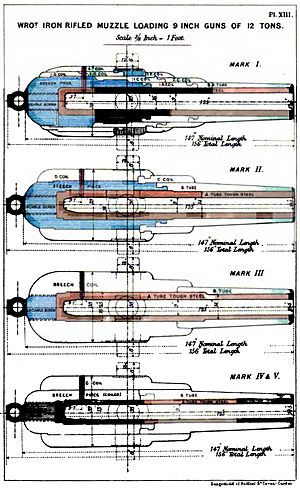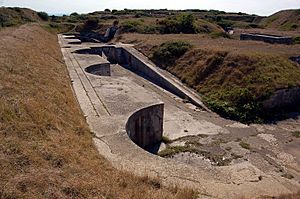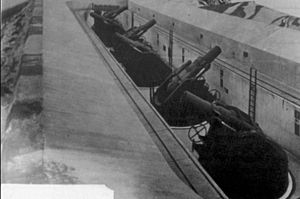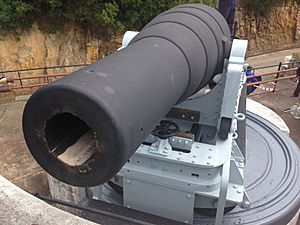RML 9-inch 12-ton gun facts for kids
Quick facts for kids Ordnance RML 9-inch 12-ton gun |
|
|---|---|
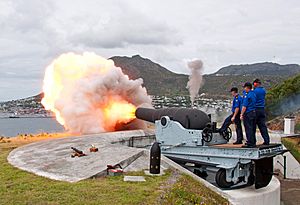
Restored Mark I, RML 9-inch 12-ton gun being fired at Simon's Town in 2014, with replica ammunition in the foreground
|
|
| Type | Naval gun Coast defence gun |
| Place of origin | United Kingdom |
| Service history | |
| In service | 1865–1922 (Mk VI) |
| Used by | Royal Navy Australian Colonies Spanish Navy |
| Wars | Bombardment of Alexandria |
| Production history | |
| Designed | 1865 |
| Manufacturer | Royal Arsenal |
| Unit cost | £1000 in 1875, £740 in 1882 |
| Variants | Mk I–VI |
| Specifications | |
| Mass | 12 |
| Length | 156 inches (4.0 m) |
| Barrel length | 125 inches (3.2 m) (bore) |
|
|
|
| Shell | Mk I–V : 250 to 256 pounds (113.4 to 116.1 kg) Palliser, Common, Shrapnel Mk VI : 360 pounds (163.3 kg) AP |
| Calibre | 9-inch (228.6 mm) |
| Breech | None,loaded through muzzle |
| Muzzle velocity | 1,420 feet per second (430 m/s) |
| Maximum firing range | 9,919 yards (9,070 m) |
The RML 9-inch guns Mark I – Mark VI were huge cannons from the 1860s. They were called 'muzzle-loading' because they were loaded from the front, and 'rifled' because they had special grooves inside to make the shells spin. These powerful guns were used on British warships and also placed on land to protect coastlines.
Contents
How the Gun Was Designed
The inside of the gun barrel had special grooves called 'rifling'. This helped the cannonball spin as it flew, making it more accurate. There were six grooves that twisted more as they went down the barrel.
The first version, Mark I, came out in 1865. It was built using a strong but expensive method designed by Armstrong. It had a steel tube surrounded by many thin iron coils. This made the central tube very strong. About 190 of these guns were made.
The Mark II, made in 1866, used a cheaper design called the Fraser method. It had fewer, but heavier, iron coils. Only 26 Mark II guns were built.
The Mark III, made in 1866–1867, fully used the Fraser design to save money. It was made of only four main parts: a steel tube, a back part, a second tube, and a coil at the back. About 136 Mark III guns were produced.
The Mark IV (1869) and Mark V versions had a thinner steel tube and two coils at the back. This change was made because it was hard to make sure large pieces of iron were perfect inside.
Special High-Angle Guns
In the late 1880s and early 1890s, some of these guns were changed to fire at a high angle. They were used for coast defense in places like Plymouth, Portland, and the Isle of Wight.
The idea was that firing shells high up would make them drop almost straight down onto enemy ships. This was important because the decks (tops) of ships were usually less armored than their sides. To make these shots more accurate, the old gun barrels were updated with new rifling.
These special high-angle guns fired a heavy 360-pound shell. They could hit targets up to 10,500 yards away. They were used even during World War I and were not considered old-fashioned until 1922.
Some of these guns were made even bigger, to fire 10-inch shells. Six of these larger guns were placed at Spy Glass Battery in Rock of Gibraltar and six more in Malta.
What the Gun Fired
The RML 9-inch guns (Marks I-V) used shells with small "studs" on them. These studs fit into the gun's rifling to make the shell spin. Later, "gas-checks" were added to the shells. These were like small rings at the back that helped seal the gas from the explosion, making the gun more accurate and shoot further.
Even later, new "automatic gas-checks" were invented. These allowed the guns to fire shells without studs. This meant the guns could use a mix of old studded shells and new studless ones. The Mark VI high-angle gun, however, could only fire the newer studless shells.
The main type of shell was the Palliser shot. This was an early type of armor-piercing shell, designed to break through the thick armor of enemy warships. To make these shells fly as fast as possible, a large amount of gunpowder was used.
Other types of shells included "common shells" (regular explosive shells) and "shrapnel shells" (shells that burst in the air and spread many small pieces). These were fired with a standard amount of gunpowder, as speed was not as important for them.
-
Studless common shell with Rotating gas-check
Surviving Examples
Many of these historic guns can still be seen today in various locations around the world.
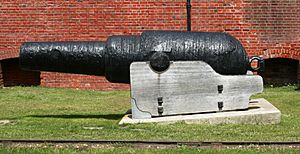
- A Mark I gun (Number 14, from 1865) is on Saint Helena.
- Another Mark I gun (Number 22) is at Middle North Battery, Simon's Town, South Africa. It is still fired sometimes!
- A Mark I gun (Number 127, from 1867) is at Castle Field, Wicklow.
- A Mark I gun (Number 148, from 1867) is at Fort St. Catherine, Bermuda.
- Mark I guns are also at Apostles Battery, St Lucia.
- Mark III and Mark IV guns can be found at Needles Old Battery, Isle of Wight, UK.
- A Mark III gun from the Needles battery is now outside Southsea Castle, Portsmouth, UK.
- Other Mark III guns from the Needles battery are at Hurst Castle, Fort Brockhurst, and Fort Widley in Hampshire, UK.
- A Mark III gun (Number 272, from 1868) is at Alexander battery, St George, Bermuda.
- A Mark V gun is at Harwich Redoubt, Essex, UK.
- A Mark V gun from 1872 is at Whampoa, Kowloon, Hong Kong.
- Another Mark V gun (Number 589, from 1872) is on Saint Helena.
- A Mark V gun (Number 592) is at South Head, Sydney, Australia.
- A Mark V gun (Number 650, from 1877) is at York Redoubt, Halifax, Canada.
- A Mark I gun (Number 1670, from 1867) is at Fort Queenscliff, Victoria, Australia.
- Guns Number 1679 and 1683 are at The Strand, Williamstown, Victoria, Australia.
- Guns Number 1669 and 1675 are at Fort Gellibrand, Victoria, Australia.
- A gun is at York Redoubt National Historic Site, Halifax, Nova Scotia, Canada.
- A gun is at The Citadel, Quebec, Canada.
See also
- List of naval guns


